
[Source:
Paul Wright & Alan Young]
Bacup Station Gallery 4: old12.jpg) The main entrance to Bacup station on Rockcliffe Road in the early 1960s. The booking office was housed in this building and behind it was the station's long island platform.
Photo from M R Nostalgic Railway Images 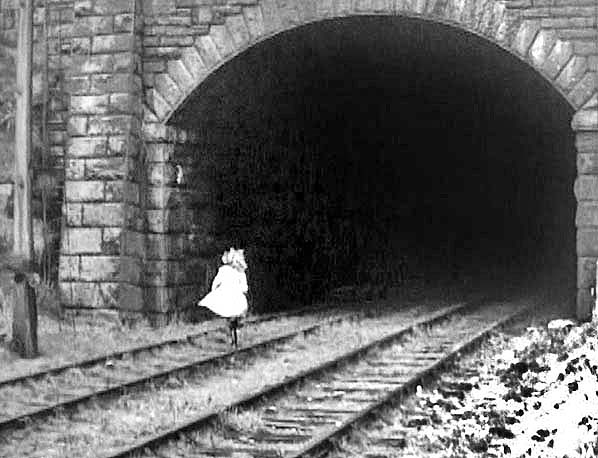
The area between Britannia and Bacup shed was used in a short sequence of the film Whistle Down the Wind of 1961, directed by Bryan Forbes: in this frame from the film, Hayley Mills is running into the north-west portal of Britannia, or New Line, Tunnel to retrieve Alan Bates’s handgun. The derelict engine shed was also seen in this sequence.
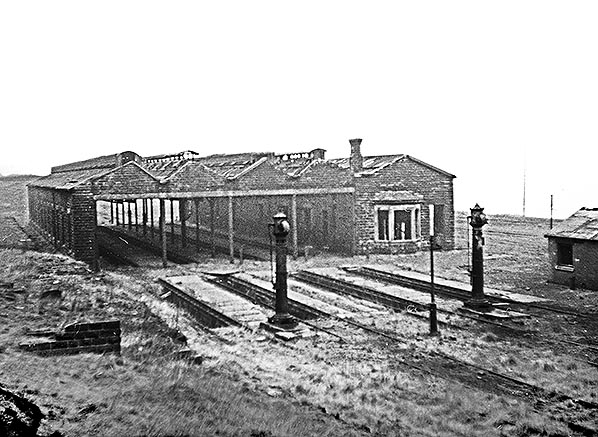
The disused engine shed at Bacup, looking north-west c1963. The 4-road shed closed in 1954, but as seen here the tracks remained in place for many years. Two water cranes are placed to serve locos on all four tracks.
Photo
by Barry Hilton
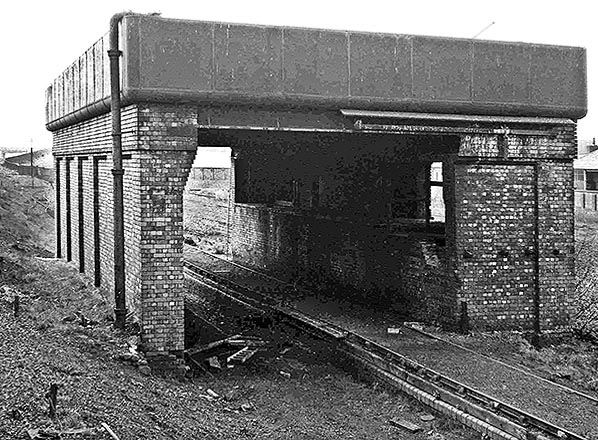 The coaling stage cum water trough a few yards south of Bacup shed is seen in 1963. The shed signal box is in the background. The shed closed in October 1954.
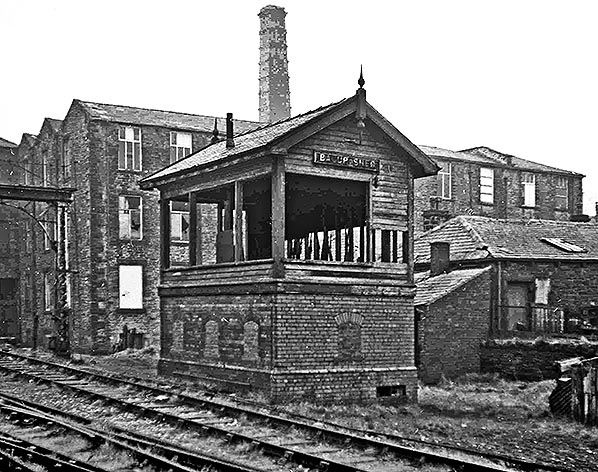
The disused Bacup Shed signal box looking south across the ‘main line’ tracks c1963. It was built in 1925 by the LMS to a London & North Western Railway design, replacing an earlier one a few yards south-east which originally carried the name ‘Britannia Engine Shed’. Bacup was briefly part of the LNWR when in 1922 this company absorbed the Lancashire & Yorkshire Railway before itself becoming a constituent of the LMS in 1923. Behind the box is Height Barn cotton mill, shown as disused on Ordnance Survey maps since 1910. At the time of this photograph, the rails have not been in use since 1954, when the engine shed closed, but the route over the summit to Facit is retained for wagon storage. By the end of 1964 the tracks had been removed.
Photo by Barry Hilton 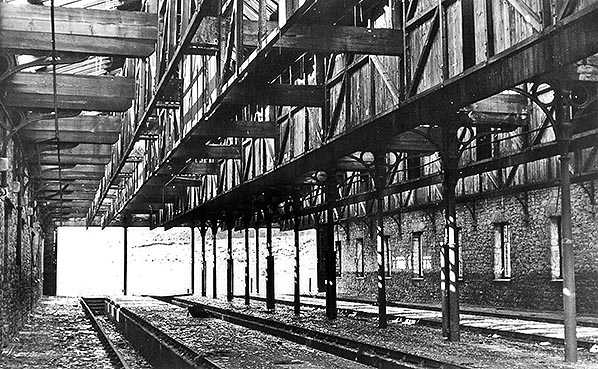
The interior of the engine shed at Bacup is seen on 26 March 1963. Despite being out of use for eight years the structure is surprisingly intact, with its inspection pits, smoke troughs and heavy wooden beams in place beneath the replacement LMS roof. The rails of the Facit Branch, officially closed but available for wagon storage, still pass by the shed at this time.
Photo by Ian G Holt old5.jpg)
Looking north at Bacup Station in August 1963. Bacup Station consisted of a single island platform which is clearly shown in the picture. As can be seen the platform was wide and had a large canopy at its northern end. Beyond the canopy to the left is the booking office which led out to the street.
Photo by Ben Brooksbank 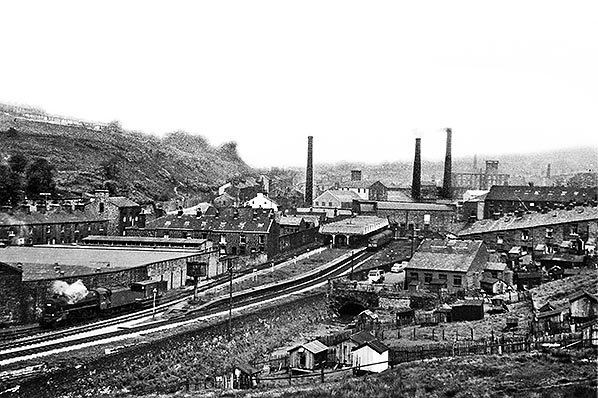
On 10 June 1966 a Cravens 2-car diesel multiple unit is at the far end of the up platform at Bacup, adjacent to the glazed roofing. To the left, ‘Black Five’ No.44728 is engaged in some shunting activity with a guard’s van. The wall of India Mill is immediately beyond the loco. The River Irwell can be seen emerging from a culvert towards the bottom of the photograph. The chimneys of Plantation, Throstle and Forest cotton mills are seen in the background. No.44728 is a Stanier-designed 4-6-0 built at British Railways’ Crewe works in January 1949 and allocated to 26C, Bolton shed. She survived into the final months of steam on BR, being withdrawn on 31 January 1968 to be disposed of at Drapers, Neptune Street Goods Yard, Hull the following May. Click here for a larger version.
Photo by Ian G Holt 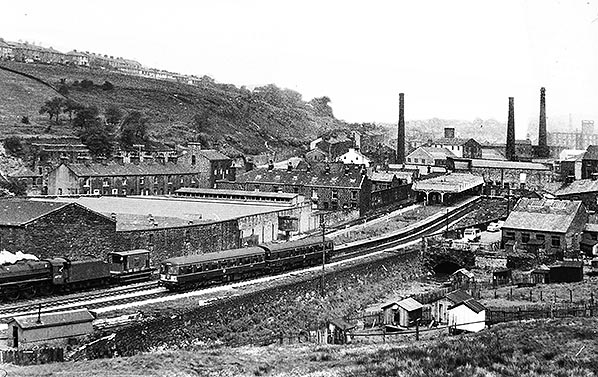
A Cravens (later Class 105) 2-car DMU is leaving Bacup on Friday 10 June 1966 en route to Rawtenstall and Bury. To the left, ‘Black Five’ No.44728 is shunting a guards van past India Mill. The River Irwell can be seen emerging from a culvert towards the bottom of the photograph. The chimneys of Plantation, Throstle and Forest cotton mills are seen in the background. No.44728 is a Stanier-designed 4-6-0 built at British Railways’ Crewe works in January 1949 and allocated to 26C, Bolton shed. She survived into the final months of steam on BR, being withdrawn on 31 January 1968 to be disposed of at Drapers, Neptune Street Goods Yard, Hull the following May.
Click here for a larger version Photo by Ian G Holt 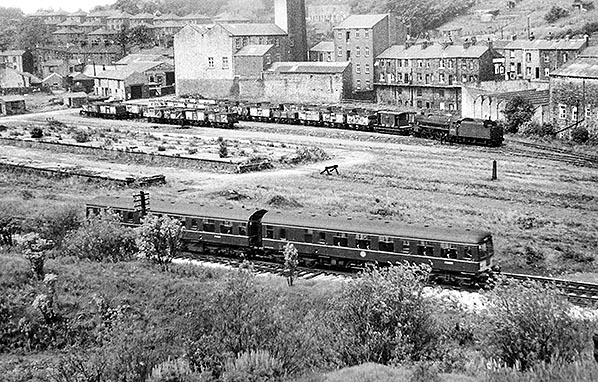
Looking north-west towards Bacup goods yard on 10 June 1966, with a Cravens DMU on the Irwell Valley route to Rawtenstall and Bury. Both the passenger and goods services would be withdrawn in just under six months’ time. The distant sidings contain some rakes of coal wagons attended by ‘Black Five’ No.44728. The goods warehouse formerly stood between the sidings with coal wagons and the running lines; the building had been seriously damaged by fire in January 1959. In the background is Pippin Bank Mill, processing cotton waste, with the tower reaching the top of the photograph, and on the extreme right is New Hey Mill which manufactures shoes and slippers – a Rossendale speciality. The loco, No.44728 is a Stanier-designed 4-6-0 built at British Railways’ Crewe works in January 1949 and allocated to 26C, Bolton shed. She survived into the final months of steam on BR, being withdrawn on 31 January 1968 to be disposed of at Drapers, Neptune Street Goods Yard, Hull the following May.
Photo by Ian G Holt old4.jpg) Looking south along the island platform that was Bacup station in the 1960s. By the time this picture was taken the station was showing signs of neglect.
Photo from Wendy Lord collection 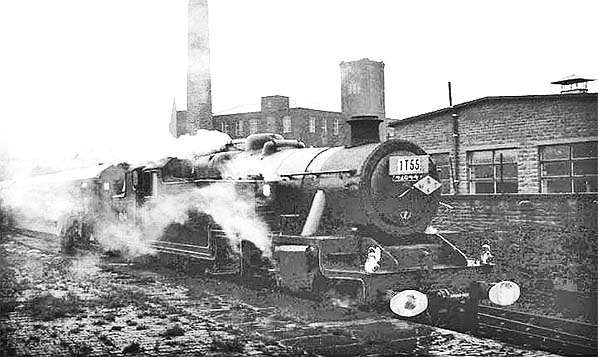
On 26 November 1966 the Manchester Rail Travel Society ran the ‘Three Counties Special’ which set out from Manchester Victoria, visited Buxton and Bacup, and ended at Manchester Central. Five locomotives hauled the special on different sections, and at Bacup Stanier 2-6-4T No.42644 is seen, having just arrived from Bury Bolton Street. The loco was built at the LMS Derby works in November 1938 and was originally numbered 2644, BR adding the ‘4’ prefix. On 11 March 1967 she was withdrawn from 13A, Trafford Park shed, and cut up by Cashmores, Great Bridge the following October. The Bacup branch was to close a week later, and it is clear that station staff had lost the will to keep the platform free of weeds.
Photo by Kenneth Gray courtesy of Bruce McCartney Click here for Bacup Station Gallery 5:
|


 Home Page
Home Page